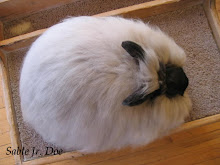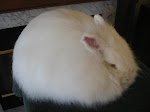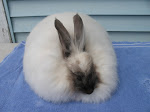-another entry from the old blog:
When I begin the culling process in my barn to single out potential show bunnies, woolers, and fryers, I usually begin at 12 weeks. The very first thing I check on each bunny before inspecting anything else is whether or not they have any DQs. If it is a colored rabbit I make sure that the color is correct for the standard description with no faults such as lack of ring definition in an Agouti, stray white hairs on the faces, feet, or ears of Selfs, and white or mismatched toenails in any color. I also select for bunnies who carry color as far down the hairshaft as possible, and display lots of intensity of color in the face.
Next I check to make sure that the tail is straight with no curves, twists, knobs, or bumps, and I check the teeth to make sure that there are no signs of malocclusion. I then hold the bunny under the armpits with the back legs hanging straight down to determine if they are parallel or turn out to the sides indicating a cowhocked HQ.
At this point the bunny gets placed on the grooming table and tucked into a correct commercial pose to assess the general type. I make sure that the front feet are parallel and directly in line with the eyes, and the back feet are parallel and directly in line with the top of the hips. Starting at the shoulders, I run my hand smoothly backward over the entire body of the rabbit from shoulder to tail. What I 'should' feel is a perfectly smooth body with no angles, low spots, or hips jutting out. My hand should not stop or get stuck from beginning to end, but should run over the entire rabbit like butter, indicating that everything is properly filled out and all the muscles are in proportion with one another.
The shoulder should be high, meaning that the average person (woman, at least) cannot touch the table with her fingertips when they are cupped over the shoulders behind the ears. Width of shoulder is important, but not particularly worrisome at this age since shoulders often widen with age. A low shoulder, however, rarely fixes itself.
The RISE of the rabbit should be good---in other words, the spine should rise immediately from behind the rabbit's ears to peak over the hip and slope gently down and around the hindquarter. There should not be any flat sections over the shoulder or anywhere else on the topline of the rabbit, and when your hand slides down to the table from the hindquarter, it should fall STRAIGHT down to the table, with no pinched-in area at the bottom of the rear end (your hand should not slope INWARD the farther down it goes, in other words).
Next, and very importantly, feel the quality of bone on the baby. Wrap your fingers around the bunny's front leg directly above the ankle and select for those rabbits who feel solid and substantial. Avoid holding onto any baby whose bones feel thin, delicate, or rickety, or you will breed rabbits into your program who do not have the framework necessary to sustain the muscle and weight associated with a good commercial type.
After evaluating color and type, it is time to take a hard look at the wool. An FA baby coat is considerably different in texture than an FA senior coat, so what you need to do is assess the coat based on what CAN be ascertained at this point, and eventually you find that you get a feel and ' gut instinct' for which coats are likely to pan out in adulthood. Ask yourself the following questions when inspecting a baby coat:
1) Is the coat evenly dense (thick) over the entire body of the rabbit? Is it equally as dense on the stomach and chest?
2) Are they any 'weak spots' in the coat--for ex.--areas where the wool is thinner or more sparse than in other places? A typical FA coat leans toward being densest along the sides of the coat including the rear end directly above the tail. Weaknesses are most often found along the spine and especially behind the ears and directly over the shoulders. Select for coats that have good thickness in these areas.
3) Can you see the guard hairs beginning to poke through in the soft coat? Proper baby texture should be neither too coarse nor too soft. You do not want a very guard hairy baby but you also don't want a coat where guard hairs are not evident anywhere. They should be present but not overly abundant, and they should definitely not be dominating the coat at this point.
4) How does the coat feel?? A baby coat should be soft but NOT cottony. If it is sticking out in a thousand different directions no matter what you do to try to groom it, chances are excellent that the texture is incorrect and the coat will remain soft and difficult to manage into adulthood. Note: Always remember that a good French coat should NOT be a chore to maintain. Even in babyhood you should be able to get away with grooming approx. once per week, particularly up to the ages of 4-- 4 1/2 months. As a baby coat gets longer and older it will be more prone to tangling, but it still should not matt up constantly if you are failing to groom it every other day.
5) Be sure that guard hair is evenly distributed throughout the coat. You do not want to see an abundance of guard hair in one section, and nothing but underwool in another section. The guards should be combined with the underwool and evenly distributed over the entire body of the rabbit with no concentration anywhere (this fault is usually more evident in adult coats, but signs of it can sometimes be seen in a baby coat if you look hard enough:)).
These are just a few things to look for when doing a first evaluation of a young rabbit. After you make your selections, hold onto the better rabbits for another 2-3 weeks and then take them out and assess them again. You will either find that the good traits you noticed first have become more pronounced, or the type has worsened or failed to fill in where you thought it would, and a good prospect has become a cull. I usually single out the bunnies who pass the first assessment, and then look at them again at 14 weeks. Those who pass the second cull at 14 weeks stick around to be looked at again at 16 weeks, and by that time I usually have a fair idea of whether I will keep and show them, at least until the senior coat comes in. The final cull comes around 9 months when adult bunnies who continue to look good and have grown in even senior coats are designated as keepers.
More next time and have a great week!:-)
Friday, January 23, 2009
Subscribe to:
Post Comments (Atom)























1 comment:
I am just learning about angoras and their care. I have one question- does culling mean what I think it means..in that they are killed or used for meat? Or do you try to find homes for them? I always wonder what breeders exactly do when culling. Thanks!
Post a Comment